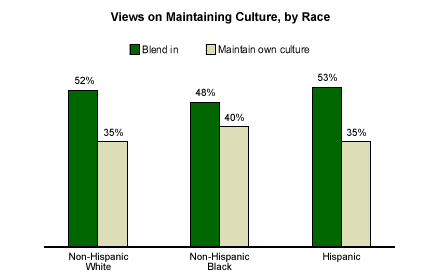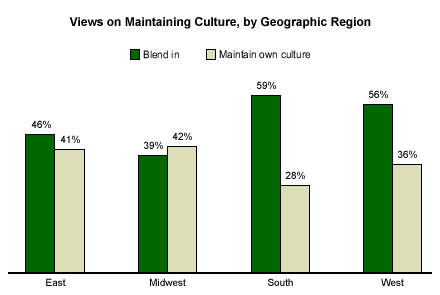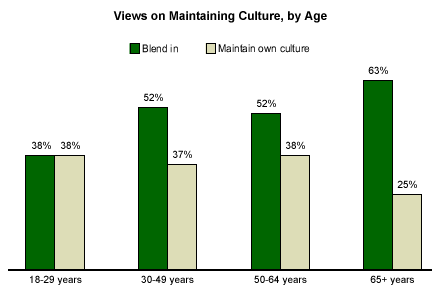The image of the United States as a melting pot lives on in the psyche of most Americans, according to a recent Gallup Poll on the state of civil rights in the nation, sponsored by AARP and the Leadership Conference on Civil Rights*. Americans, including those who belong to ethnic and racial minority groups, are more likely to believe that it is better for the United States if minorities "blend in" with American culture rather than maintaining their own cultures more strongly.
About half of Americans (51%) think it is better for the United States if racial and ethnic minorities are encouraged to blend into American culture by giving up some important aspects of their own cultures. Approximately a third of the overall American population (36%), on the other hand, thinks it is better for the United States if racial and ethnic minorities are encouraged to maintain their own cultures more strongly, even if that means they do not blend into American culture as well.

The data show that responses are fairly consistent across different racial and ethnic groups. Whites' and Hispanics' views are the most similar, with 52% and 53%, respectively, thinking it best that minorities blend into American culture, and 35% of each believing that minorities should maintain their own cultures. Almost half of black respondents (48%) agree that it is better for the United States if minorities blend into American culture, and 40% feel that minorities should maintain their own cultures.

Views on this topic also differ by geographic region. Americans living in the South and West are more likely than those in the Midwest to think that minorities should blend into American culture. More than half of respondents in the South (59%) and West (56%) feel that minorities should blend in, while slightly less than half of Easterners (46%) agree with this sentiment -- as do only 39% of those living in the Midwest.
Interestingly, the South and West -- the regions where respondents are most likely to think minorities should blend in -- include three of the four states that are experiencing the largest influxes of immigrants. According to the 2002 Yearbook of Immigration Statistics (the most recent year for which data are available), 291,216 legal immigrants chose California as their state of residence that year -- more than a quarter of the total number of U.S. immigrants. The Eastern state of New York ranked a distant second, with 114,827 immigrants, but was followed closely by two Southern states -- Florida (90,819) and Texas (88,365).

Younger respondents are more likely to reject the cultural homogeneity of the melting-pot analogy than are older Americans. Slightly more than a third (38%) of Americans between the ages of 18 and 29 think that minorities should blend into American culture, while the same number believe that minorities should maintain their own cultures. (The remainder answered either "both equally" or "don't know.") Across the older age groups, about half of Americans agree that minorities should blend in, and this percentage reaches as high as 63% among those aged 65 and older.

Bottom Line
Americans continue to prefer a "melting pot" model when considering how minorities should adapt to American culture, although younger Americans seem to be less attracted to this model than are older Americans. This phenomenon may reflect the idea that as the country becomes more multicultural, it becomes more difficult to characterize "American" culture in any systematic way. While in 2000, 69.4% of the population was white (non-Hispanic), the U.S. Census Bureau projects that by 2050, this percentage will drop to just 50.1%. Given such trends, among future generations the iconic image of the melting pot may give way to a more pluralistic "stew" in which each element maintains its distinct flavor.
*The AARP/Gallup poll results are based on telephone interviews with 2,002 adults, aged 18 and older, conducted between Nov. 11-Dec. 14, 2003. For results based on the total sample, one can say with 95% confidence that the margin of sampling error is ±5 percentage points.
For results based on the 446 national adults who identify as African American/black -- but not Hispanic, the maximum margin of sampling error is ±8.5 percentage points.
For results based on the 915 national adults who identify as white -- but not Hispanic, the maximum margin of sampling error is ±6.7 percentage points.
For results based on the 551 national adults who identify as Hispanic -- including those who identify as white or black or other, the maximum margin of sampling error is ±6.2 percentage points.
In addition to sampling error, question wording and practical difficulties in conducting surveys can introduce error or bias into the findings of public opinion polls.
